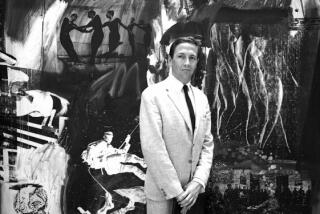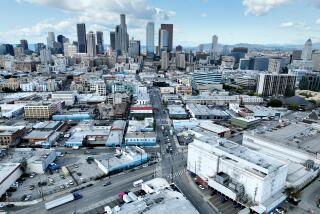Unlocking Gateway Competition
- Share via
“Your dismissal of the West Coast Gateway competition was a cop-out,” complained a reader in a telephone call responding to my suggestion in last week’s column that the five submissions selected as semi-finalist be “given the gate.”
“You didn’t write about what you didn’t like about the submissions; you didn’t even give a hint at what they were, or who were the architects,” he declared. The caller also questioned my perspective and, in effect, challenged me to come up with a better idea.
Actually, before it was submerged in an international design competition, the original idea of a gateway downtown celebrating Los Angeles as a welcoming port of entry had merit. Indeed, the idea still has merit.
Initially proposed by a committee convened by Mayor Tom Bradley was some sort of pedestrian-oriented, evocatively landscaped deck bridging the Hollywood Freeway at Spring, Main and Los Angeles streets, which would serve as a symbolic gateway to the city and both a physical and cultural connection between the Civic Center, Little Tokyo, Chinatown, Bunker Hill and El Pueblo de Los Angeles Park at Olvera Street.
In addition to the connection, the deck also was seen as providing a burgeoning area of downtown with some desperately needed open space. Such decking of freeways is quite feasible, especially if the roadway authority is for it, as Caltrans says it is. Among places where this has worked is downtown Seattle, where the deck is an attractive park, and in Brooklyn Heights, N.Y., where it forms a promenade with magnificent views of the Lower Manhattan skyline. (For movie buffs, the promenade was a prominent location in “Moonstruck.”)
As a member of the committee, science fiction author Ray Bradbury envisioned the deck as a vital link in a “yellow brick road” that would encourage people to get out of their cars and explore the diverse neighborhoods of downtown. Also discussed by the committee headed by architect David Jay Flood was the possibility of a modest exhibition space, along with cafes. But according to Flood and others, the original emphasis was on urban design and landscaping, not architectural edifices.
Unfortunately, the program narrative for the subsequent competition hailed by Bradley was not particularly clear on this critical issue. In addition, the letter sent out to potential competitors talked about “a facility,” and “a center,” no doubt misleading some competitors, while discouraging designers with a landscaping orientation from entering.
Not encouraging either was that the majority of the members of the jury selected were not familiar with the site, or city. Despite the blessing of the mayor and the good intentions of competition Chairman Nick Patsaouras, it seemed to me that the gun was loaded for the city to once again shoot itself in the foot.
With this having set the tone for the competition, I was informed late on Aug. 15 that the submissions were to go on display at the County Museum of Science and Industry in Exposition Park the next day. At the exhibit the media was told that the semi-finalists had been selected, an event subsequently covered by the Metro section of this newspaper.
Nevertheless, I did think the competition deserved mention in my column, no matter how badly managed by the sponsors, misinterpreted by the competitors and misjudged by the jury. Since my upcoming column, which already had been written, coincidentally addressed the issue of public art, it was relatively easy to add a few paragraphs at the end concerning the competition; hence my brief, if pointed, comments of last Sunday.
As they indicated, I was not impressed with the schemes selected--all tended to be structures feigning monumentality in various styles squatting on the proposed deck. Instead of somehow serving the city and acting as symbols, they seemed to be impositions.
They included what looked to me like a clutter of cliches garnered from recent trade expositions by Irmfried Windbichler of Austria, from world’s fairs by Hani Rashid, of New York, and a trendy, studied deconstructivist collage by Dagmar Richter of Cambridge, Mass.
The most fanciful was an immense expressionistic bird (of paradise?) laying an egg. It was proposed by Vilen Kunnapu and Ain Padrik of Soviet Estonia. Also selected was what appeared to be a hard-edged, high-tech harvester parked above the freeway, by Neil Denari of Los Angeles.
Granted that this is the first stage of the competition, and that the five survivors now will have an opportunity to visit the site, meet with select jury members and others involved, discuss further the goals of the competition and refine their submissions. Indeed, according to the fine print of the rules and procedures of the competition, “because the first stage submissions may identify new opportunities or significant gaps in the first stage written program the sponsors may modify, amend and/or expand upon the original program for the purposes of the second stage.”
Nevertheless, it is clear from my perspective that the competition has gone seriously astray. Because of the confused program discouraging and misleading entries, the city obviously was dealt a hand from less than a full deck. Given the prominence and potential of the site, the city deserves more.
When the submissions were first unveiled to the jury, according to someone who was there, a few members commented that none measured up to the concept of the competition. Nonetheless, the jury slogged on and came up with the five schemes with the hope that they can be improved.
My feeling is that the initial response of a few of the jurors was correct; and that the sponsors bite the bullet and admit the competition was a failure. There is no need for the city or the semi-finalists to be kidded any further. Even if any of those designs could be built, and I doubt funds could be raised to build them, they should not be built.
Still, the gateway concept has merit. What is needed is a clearly written program stressing urban design, bounded by the constraints of reality, and a new, better-organized competition, perhaps following a “yellow brick road.” One hopes the city can learn from its mistakes. Happily this one is just in the paper stages, and not yet set in concrete.
More to Read
The biggest entertainment stories
Get our big stories about Hollywood, film, television, music, arts, culture and more right in your inbox as soon as they publish.
You may occasionally receive promotional content from the Los Angeles Times.










